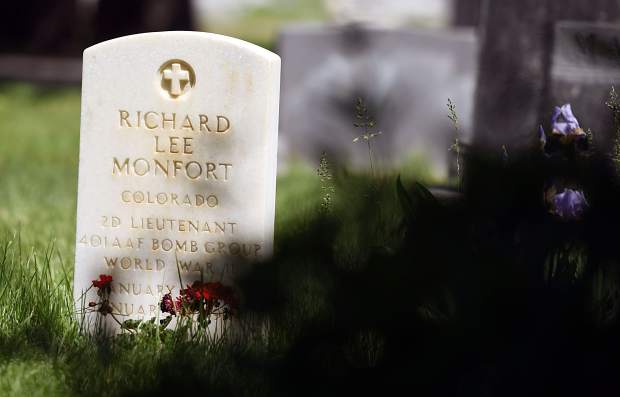29 May On Memorial Day, a salute to another Dick Monfort

In advance of the Memorial Day weekend, Greeley’s sprawling Linn Grove Cemetery was virtually deserted Friday. Sprinklers seemed noisy. After a visit to the main office to get a map and directions from Jackie at the reception desk, I pulled up to Block 14, Lot 50 and got out of the car.
There it was.
Among the graves of other Monfort family members, the white marble, U.S. military-style headstone announced:
RICHARD LEE MONFORT
COLORADO
2D LIEUTENANT
401AAF BOMB GROUP
WORLD WAR II
JANUARY 11, 1923 – JANUARY 29, 1944
A single bouquet of flowers already was at the foot of the headstone.
» » »
Richard Lee “Dick” Monfort was the son of Greeley cattle feedlot innovator Warren Monfort and Edith Monfort. Dick’s sister, Margery, was two years older. His brother, Kenneth (“Kenny”), was nearly six years younger.
After graduating from Greeley High in 1939, Dick was a junior at Colorado State College of Agriculture and Mechanic Arts, or what now is Colorado State University, when he entered the Army Air Forces in 1942.
While in training, he married Viola Swanson of Greeley.
In late 1943, Monfort was deployed to Deenethorpe, England, with the 8th Air Force’s 401st Bomb Group, 615th Squadron, joining the fight against Germany. He was the navigator on Capt. Lee Van Syckle’s B-17 “Flying Fortress” bomber crew.
A massive 800-bomber daylight raid over Frankfurt was the 10-man crew’s third mission. It also was the first U.S. bombing foray to the central German city following many earlier British raids.
The date was JANUARY 29, 1944.
Denver radio personality Rick Crandall tirelessly champions veterans causes. His efforts led to the opening of the Colorado Freedom Memorial in May 2013 in Aurora. Before its dedication, Crandall alerted me Richard L. Monfort’s name was on the memorial, among those of nearly 6,000 Coloradans killed or missing in action while serving their country.
Crandall also obtained and forwarded to me the “Missing Air Crew Report,” opened after the mission and supplemented over the next 18 months. It was declassified in 1973, and as is the case with most reports of that era based on interviews with survivors, it is remarkable in its narrative detail, especially given the staggering number of similar reports that had to be done.

